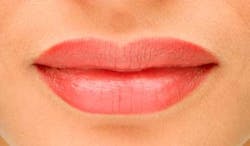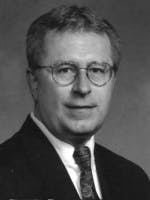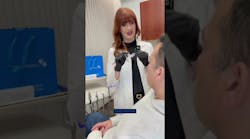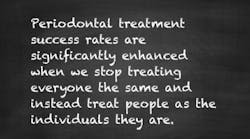Times of change
In a recent President’s Message in the International Journal of Dental Hygiene (IJDH), I shared my thoughts on “The future of the dental hygiene profession.(1) The January issue of the Journal of Periodontology featured Dr. Donald Clem‘s AAP President's Address.(2) I agree with what Dr. Clem said about his profession, and I believe some of his thoughts can be applied to the profession of dental hygiene. “I believe the best is yet to come for our specialty.” One of the aspects of dental hygiene is clinical practice, as we have known it for years. However, and again I agree with Dr. Clem, “those who have defined themselves in one dimension and do not practice the full scope of periodontology will not be prepared to participate or contribute to the renaissance of the periodontology yet to be.” The same can be said of dental hygiene. This is a time of change, and in a recent publication from the American Dental Hygienists’ Association (ADHA), it states that the dental hygiene profession is coming to a crossroads of change that may require difficult personal and collective decisions to either "seize new roles and leadership opportunities or stay with a familiar yet possibly declining direction."(3) The ADHA commissioned the environmental scan to help ADHA members explore the future of oral health and the changes dental hygienists must make to contribute to the health and well-being of society. It deliberately focuses on issues that challenge assumptions about the profession and suggest exploring new and often challenging opportunities. I encourage you to read the reports mentioned and share your thoughts with me.According to ADHA President Pam Quinones, “I’ve found that as I’ve traveled across this country and I speak with so many different hygienists, one of the big concerns hygienists have today is the future of their professional career. Clinical positions are being eliminated, or many of the hygienists I have talked to are underemployed, and it’s a real concern for ADHA. We want to help them and give them the tools to navigate the future of the profession. One of our goals is to help them understand our environmental scan. It’s a good look at the future and we want to give them the tools that they may need to navigate this future.”(4) Register for Dental Hygiene in a Changing World: Leading and Developing Your Career.(5) This exciting new workshop is designed to assist dental hygienists in developing leadership skills and to prepare hygienists to use these new skills to navigate their changing professional landscape. The inaugural workshop will be held on Saturday, February 25, 2012, in Chicago.In the spirit of change, those not comfortable with the status quo will lead the way to the future, moving the profession to new places and possibilities. Researchers continue to define the role of bacteria and inflammation in periodontal diseases and its effect on systemic health. Systemic and local delivery systems continue to be studied, as well as new and innovative therapies. In addition to antibiotics to destroy or control the bacteria that cause periodontal infection, we are looking at the host response and ways to alter it to fight infections. Whether we focus on the role of saliva, antioxidants, lipoxins, resolvins, or tissue and bone regeneration, we are looking to novel ways to address the challenge of diagnosing, treating, and controlling periodontal diseases.
We welcome questions and comments that bring to light difficult choices in the area of patient care, such as clinical practice, research, ethics, etc. If you want to debate an issue, please email me and we can make that happen!
References
1. President’s Address. The future of the dental hygiene profession. Int J Dent Hygiene 10, 2012; 1–2. onlinelibrary.wiley.com/doi/10.1111/j.1601-5037.2011.00544.x/pdf.
2. Clem DS. AAP President's Address. Journal of Periodontology 16 January 2012: 1-2.
3. Rhea M, Bettles C. Dental Hygiene at the Crossroads of Change: Environmental Scan 2011–2021. Chicago, IL, American Dental Hygienists’ Association (ADHA), 2011. Available at www.adha.org/downloads/ADHA_Environmental_Scan.pdf (accessed 16 January 2012).
4. www.adha.org/enews/2012/01182012.html#Dental.
5. adha.org/professionals/index.htm.
6. RJ Waddington RJ, Moseley R, and Embery G. Periodontal Disease Mechanisms: Reactive oxygen species: a potential role in the pathogenesis of periodontal diseases Oral Diseases, Volume 6, Issue 3, pages 138–151, May 2000.
7. Chapple ILC, Brock G, Eftimiadi C, and Matthews JB. Glutathione in gingival crevicular fluid and its relation to local antioxidant capacity in periodontal health and disease. Mol Path 2002 55: 367-373.
8. Govindaraj J, Emmadi P, and Puvanakrishnan R. Therapeutic effects of proanthocyanidins on the pathogenisis of periodontitis – An overview. Indian Journal of Experimental Biology, Vol 49,Feb 2011, pp.83-93.
9. Santos-Buelga C and Scalbert A, Proanthocyanidins and tannin-like compounds – nature, occurrence, dietary intake and effects on nutrition and health Journal of the Science of Food and Agriculture: Special Issue: Nutritional Enhancement of Plant-based Food in European Trade (NEODIET), Volume 80, Issue 7, pages 1094–1117, 15 May 2000.
10. abclocal.go.com/wabc/story.
11. Dental Care Guidelines Task Force. AAHA Dental Care Guidelines. Journal of the American Animal Hospital Association, September/October 2005, Vol 41, 1-7. www.aahanet.org/publicdocuments/painmanagementguidelines.pdf.
Sincerely,
Maria Perno Goldie, RDH, MS
To read previous RDH eVillage FOCUS introductions by Editorial Director Maria Perno Goldie, go to introductions.









